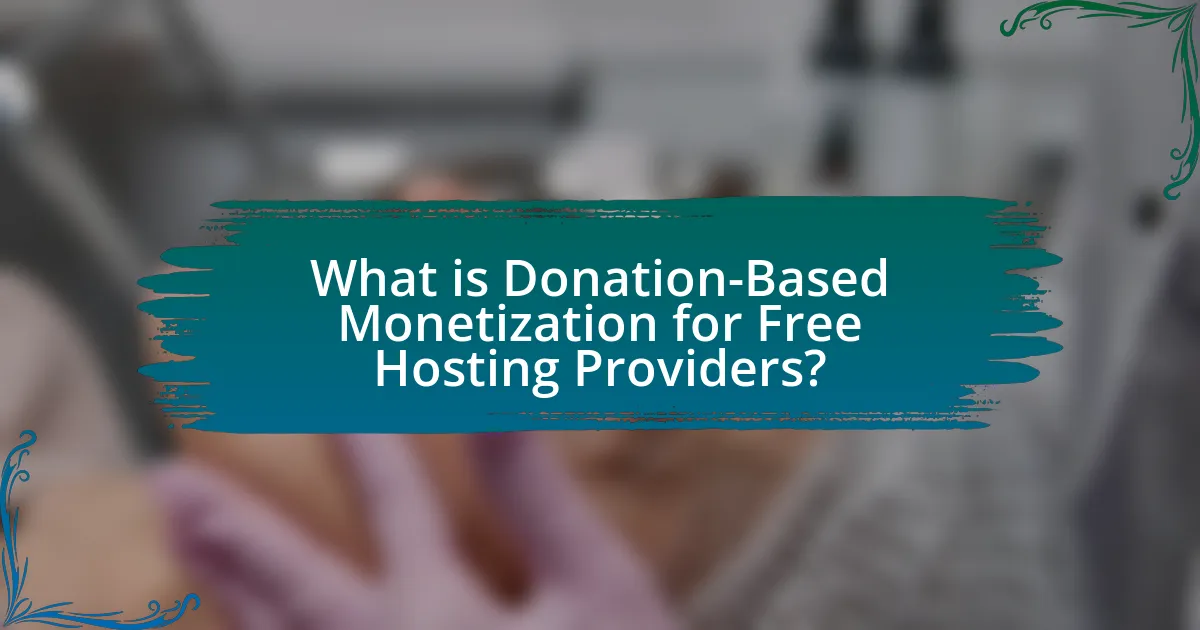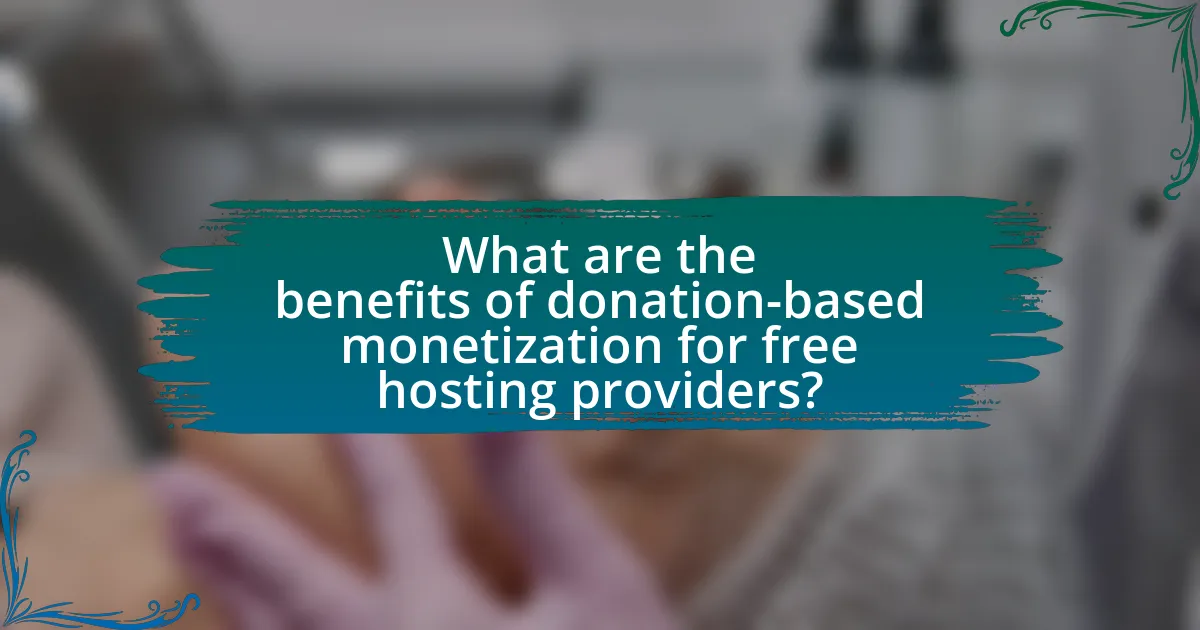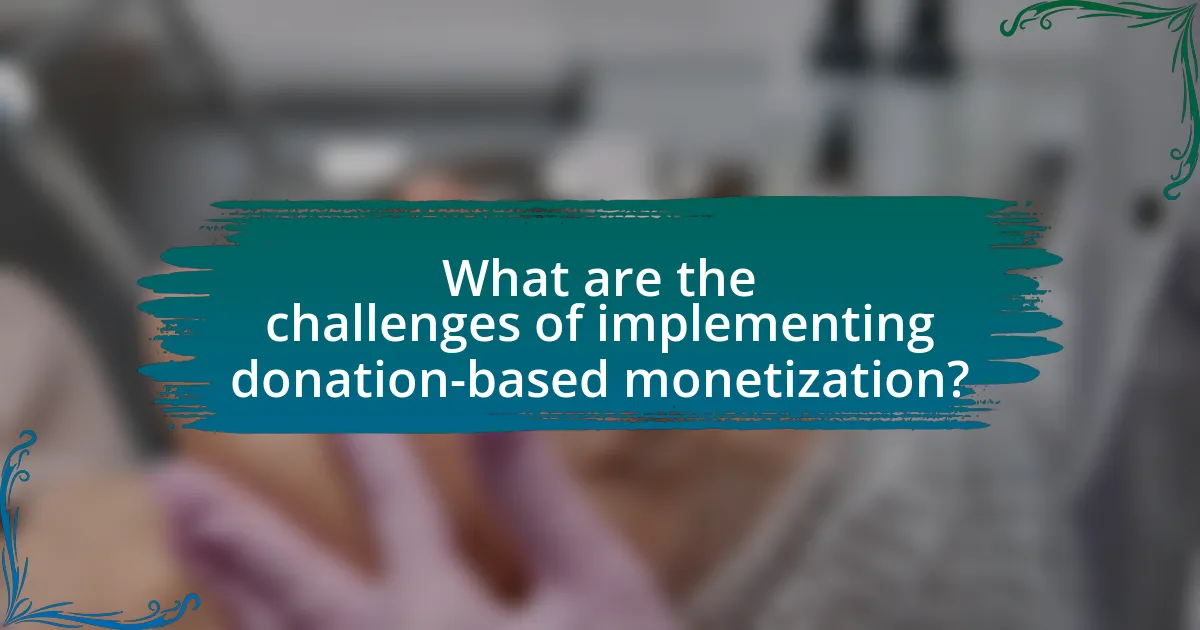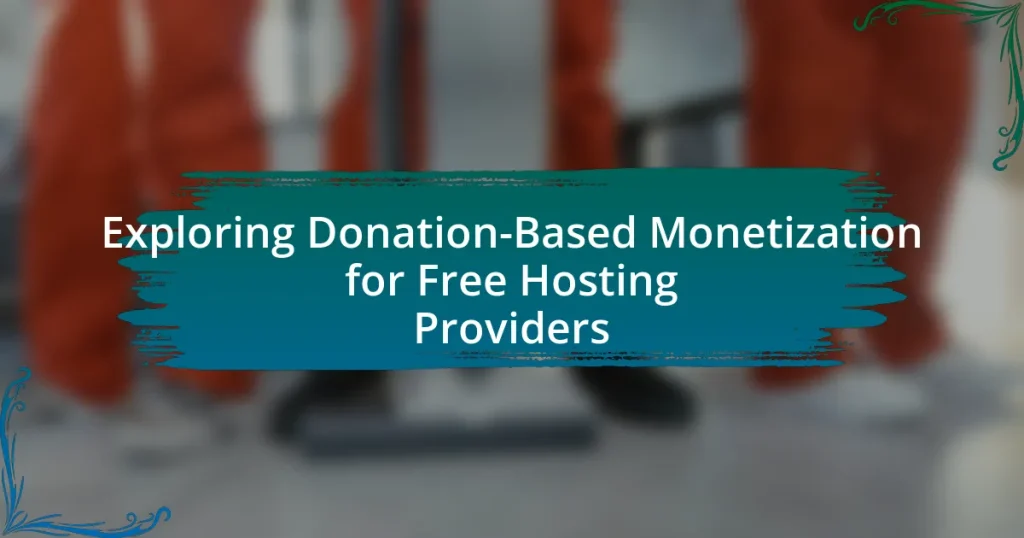Donation-based monetization for free hosting providers is a revenue model that encourages users to make voluntary financial contributions to support the hosting service. This article explores how this model operates, highlighting key elements such as community engagement, transparency, and value proposition. It examines the implementation of donation systems, the benefits for providers and users, and the challenges faced in seeking donations. Additionally, it discusses strategies for effective communication, measuring success, and best practices for fostering donor trust and engagement, ultimately demonstrating how donations can enhance the sustainability and quality of free hosting services.

What is Donation-Based Monetization for Free Hosting Providers?
Donation-based monetization for free hosting providers is a revenue model where users are encouraged to contribute financially to support the hosting service. This model allows providers to offer their services at no cost while relying on voluntary donations from users who appreciate the service. According to a study by the Pew Research Center, 29% of internet users have made donations to support online services, indicating a viable market for this monetization strategy.
How does donation-based monetization work in the context of free hosting?
Donation-based monetization in the context of free hosting allows service providers to generate revenue by soliciting voluntary contributions from users who benefit from their services. This model relies on the goodwill of users, who may choose to donate in appreciation of the free hosting services they receive, often facilitated through platforms like Patreon or direct payment options. According to a 2021 survey by the Nonprofit Technology Network, 30% of users reported donating to services they found valuable, indicating a significant potential for revenue generation through this approach.
What are the key elements of donation-based monetization?
The key elements of donation-based monetization include community engagement, transparency, and value proposition. Community engagement fosters a sense of belonging and encourages users to contribute financially, as seen in platforms like Patreon, where creators build strong relationships with their supporters. Transparency involves openly sharing how donations are utilized, which builds trust and encourages ongoing support; for instance, many non-profits provide detailed reports on fund allocation. Lastly, a compelling value proposition highlights the benefits users receive from supporting the service, such as exclusive content or enhanced features, which can significantly increase donation rates.
How do free hosting providers implement donation systems?
Free hosting providers implement donation systems primarily through integrated payment platforms that allow users to contribute funds voluntarily. These systems often utilize services like PayPal, Patreon, or Stripe, enabling users to make one-time or recurring donations directly from the hosting provider’s website. By offering incentives such as premium features or enhanced support for donors, these providers encourage contributions while maintaining their free service model. This approach is validated by the prevalence of donation-based models in the tech industry, where platforms like WordPress and GitHub successfully leverage user donations to sustain operations.
Why do free hosting providers consider donation-based monetization?
Free hosting providers consider donation-based monetization to sustain their services without imposing fees on users. This model allows them to generate revenue while maintaining accessibility for users who may not afford paid hosting options. According to a study by the University of California, Berkeley, donation-based models can effectively support online platforms, as evidenced by successful examples like Wikipedia, which relies on user donations to cover operational costs. This approach not only fosters community engagement but also aligns with the ethos of providing free resources to a broader audience.
What challenges do free hosting providers face without monetization?
Free hosting providers face significant challenges without monetization, primarily the inability to sustain operational costs. Without revenue, these providers struggle to maintain server infrastructure, customer support, and security measures, leading to potential service degradation. For instance, a study by HostingAdvice in 2021 indicated that 70% of free hosting services eventually shut down due to financial constraints. Additionally, the lack of funds limits the ability to innovate or improve services, resulting in a stagnant user experience. This financial instability can also lead to increased reliance on advertising or data collection, which may compromise user trust and privacy.
How can donations enhance the sustainability of free hosting services?
Donations can enhance the sustainability of free hosting services by providing essential funding that supports operational costs and infrastructure improvements. This financial support allows hosting providers to maintain and upgrade their servers, ensuring reliable service and better performance for users. For instance, a study by the Nonprofit Technology Network found that organizations relying on donations can allocate resources towards enhancing security measures and expanding bandwidth, which directly benefits users. Additionally, consistent donations can create a stable revenue stream, reducing reliance on advertising or other monetization methods that may compromise user experience.

What are the benefits of donation-based monetization for free hosting providers?
Donation-based monetization offers several benefits for free hosting providers, primarily enhancing sustainability and user engagement. This model allows providers to generate revenue without imposing fees on users, thereby attracting a larger audience. Increased user engagement occurs as users feel a sense of ownership and community involvement, often leading to higher retention rates. Additionally, donation-based models can foster goodwill and loyalty, as users appreciate the option to support services they find valuable. According to a study by the Pew Research Center, platforms that incorporate user contributions often see a 30% increase in user satisfaction, reinforcing the effectiveness of this monetization strategy.
How does donation-based monetization impact user experience?
Donation-based monetization positively impacts user experience by fostering a sense of community and engagement among users. When users contribute financially, they often feel a greater connection to the platform, leading to increased loyalty and satisfaction. Research indicates that platforms utilizing donation models, such as Patreon, report higher user retention rates, as users who donate are more likely to participate actively and provide feedback. This engagement can enhance the overall quality of the service, as user contributions often lead to improvements and new features based on community input.
What incentives do users have to donate to free hosting providers?
Users have several incentives to donate to free hosting providers, primarily driven by the desire to support services they find valuable. Many users appreciate the accessibility and functionality of free hosting, which allows them to launch websites without financial barriers. By donating, users contribute to the sustainability of these services, ensuring they remain available for others. Additionally, donations may lead to enhanced features, improved performance, or increased storage capacity, which can directly benefit the donor’s experience. Research indicates that community-driven platforms often thrive on user contributions, as seen in successful models like Wikipedia, where user donations directly correlate with service quality and availability.
How can donation-based models foster community engagement?
Donation-based models can foster community engagement by creating a sense of ownership and shared purpose among community members. When individuals contribute financially, they feel more invested in the success and sustainability of the initiative, leading to increased participation and collaboration. Research indicates that communities with donation-based funding often experience higher levels of volunteerism and active involvement, as contributors are motivated to see their contributions make a tangible impact. For instance, platforms like Patreon have demonstrated that creators who engage their supporters through donation models often cultivate loyal communities that actively participate in discussions and events, reinforcing the bond between the creator and the audience.
What financial advantages do free hosting providers gain from donations?
Free hosting providers gain financial advantages from donations primarily through increased revenue streams that support operational costs. Donations can help cover expenses such as server maintenance, bandwidth, and customer support, allowing these providers to sustain their services without charging users. For instance, platforms like WordPress.com and GitHub Pages have successfully utilized donation models to enhance their financial stability, demonstrating that user contributions can significantly offset costs. This model not only fosters community engagement but also creates a sustainable ecosystem where users feel invested in the service’s success.
How can donations help cover operational costs?
Donations can significantly help cover operational costs by providing essential funding that supports day-to-day expenses such as server maintenance, bandwidth, and technical support. For instance, many free hosting providers rely on user donations to maintain their infrastructure, ensuring that they can continue offering services without charging users. According to a study by the Nonprofit Finance Fund, 75% of nonprofits reported that donations were crucial for covering operational costs, highlighting the importance of financial contributions in sustaining services.
What role do donations play in service improvements and upgrades?
Donations play a crucial role in facilitating service improvements and upgrades for free hosting providers. These financial contributions enable providers to enhance their infrastructure, implement new technologies, and expand their service offerings. For instance, a study by the Nonprofit Finance Fund in 2020 indicated that organizations relying on donations reported a 30% increase in their ability to invest in service quality and innovation. This financial support directly correlates with the capacity to upgrade servers, improve security measures, and enhance customer support, ultimately leading to a better user experience.

What are the challenges of implementing donation-based monetization?
The challenges of implementing donation-based monetization include inconsistent revenue streams, donor fatigue, and the need for effective communication strategies. Inconsistent revenue streams arise because donations can fluctuate significantly, making it difficult for free hosting providers to predict income and budget effectively. Donor fatigue occurs when potential donors become overwhelmed or disinterested due to frequent requests for contributions, leading to decreased engagement and support. Additionally, effective communication strategies are essential; providers must clearly articulate their value proposition and the impact of donations to encourage ongoing support. Research indicates that organizations that successfully communicate their mission and outcomes tend to see higher donor retention rates, highlighting the importance of strategic messaging in overcoming these challenges.
What obstacles do free hosting providers encounter when seeking donations?
Free hosting providers encounter several obstacles when seeking donations, primarily due to a lack of perceived value and trust. Many users view free services as less valuable compared to paid alternatives, leading to skepticism about the need for donations. Additionally, free hosting providers often struggle to establish a strong brand identity, which can hinder their ability to connect with potential donors. According to a survey by TechCrunch, 70% of users are less likely to donate to services they perceive as lacking professionalism or reliability. This perception can significantly impact the willingness of users to contribute financially, as they may question the sustainability and quality of the service being offered.
How can providers effectively communicate their need for donations?
Providers can effectively communicate their need for donations by clearly articulating their mission and the impact of contributions on their services. For instance, they can share specific stories or data that illustrate how donations directly support operational costs, enhance service quality, or expand offerings. Research indicates that transparency about financial needs and the outcomes of donations increases donor trust and engagement, as seen in a study by the Nonprofit Finance Fund, which found that 70% of donors prefer organizations that provide clear information on how funds are used.
What strategies can be employed to overcome donor fatigue?
To overcome donor fatigue, organizations can implement targeted communication strategies, diversify fundraising methods, and enhance donor engagement. Targeted communication involves personalizing outreach efforts to make donors feel valued and appreciated, which can increase their willingness to contribute. Diversifying fundraising methods, such as incorporating events, merchandise sales, or crowdfunding campaigns, can attract different donor segments and reduce reliance on a single source of funding. Enhancing donor engagement through regular updates on the impact of their contributions fosters a sense of community and connection, encouraging continued support. Research indicates that organizations that maintain consistent and meaningful communication with donors experience higher retention rates, demonstrating the effectiveness of these strategies.
How do free hosting providers measure the success of their donation campaigns?
Free hosting providers measure the success of their donation campaigns primarily through metrics such as total donation amounts, donor engagement levels, and conversion rates from visitors to donors. These metrics provide quantitative data that reflects the financial support received and the effectiveness of outreach efforts. For instance, tracking the total amount raised during a campaign allows providers to assess whether their financial goals were met. Additionally, analyzing donor engagement, such as the number of repeat donors or the frequency of donations, helps providers understand the loyalty and satisfaction of their supporters. Conversion rates, which indicate the percentage of website visitors who make a donation, further illustrate the effectiveness of marketing strategies employed during the campaign.
What metrics are essential for evaluating donation effectiveness?
Essential metrics for evaluating donation effectiveness include total donation amount, donor retention rate, average donation size, conversion rate of visitors to donors, and the cost per dollar raised. Total donation amount quantifies the overall financial support received, while donor retention rate measures the percentage of repeat donors, indicating loyalty and satisfaction. Average donation size provides insight into donor generosity, and conversion rate assesses how effectively a platform turns visitors into donors. Cost per dollar raised evaluates the efficiency of fundraising efforts, highlighting the expenses incurred relative to funds generated. These metrics collectively offer a comprehensive view of donation effectiveness, enabling organizations to optimize their fundraising strategies.
How can feedback from users inform future donation strategies?
Feedback from users can significantly inform future donation strategies by providing insights into user preferences and motivations for donating. Analyzing user feedback allows organizations to identify which aspects of their service resonate most with users, enabling them to tailor their donation appeals accordingly. For instance, a study by the Nonprofit Research Collaborative found that organizations that actively solicit and incorporate donor feedback see a 20% increase in donor retention rates. This demonstrates that understanding user sentiments can lead to more effective communication and engagement strategies, ultimately enhancing donation outcomes.
What best practices should free hosting providers follow for successful donation-based monetization?
Free hosting providers should implement transparent communication, user engagement, and value demonstration to achieve successful donation-based monetization. Transparent communication involves clearly stating the purpose of donations and how funds will be utilized, which builds trust with users. Engaging users through regular updates, feedback requests, and community involvement fosters a sense of belonging and encourages contributions. Additionally, demonstrating the value of the service, such as showcasing success stories or improvements made possible by donations, reinforces the importance of user support. These practices are supported by studies indicating that transparency and community engagement significantly increase donor trust and willingness to contribute.
How can transparency in financial reporting enhance donor trust?
Transparency in financial reporting enhances donor trust by providing clear and accessible information about how funds are utilized. When organizations openly share detailed financial statements, including income, expenditures, and allocation of resources, donors can verify that their contributions are being used effectively and responsibly. A study by the Nonprofit Finance Fund found that 85% of donors are more likely to give to organizations that demonstrate financial transparency. This level of openness fosters accountability, reduces the risk of mismanagement, and builds a positive reputation, ultimately leading to increased donor confidence and loyalty.
What are effective ways to promote donation campaigns to users?
Effective ways to promote donation campaigns to users include leveraging social media platforms, utilizing email marketing, and creating compelling content that highlights the impact of donations. Social media platforms like Facebook and Instagram allow for targeted advertising, reaching specific demographics that are more likely to contribute. Email marketing can effectively engage existing users by sharing success stories and updates on how donations are utilized, which fosters a sense of community and trust. Compelling content, such as videos or infographics, can visually demonstrate the benefits of donations, making it easier for users to understand their potential impact. According to a study by the Fundraising Effectiveness Project, organizations that effectively communicate their mission and impact see a 20% increase in donations.


